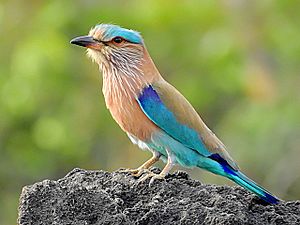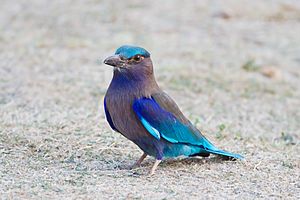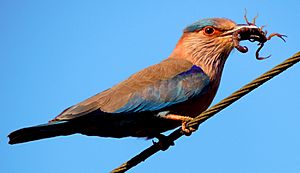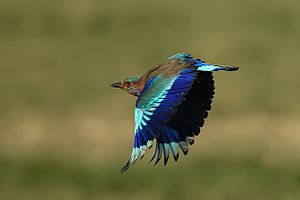Indian roller facts for kids
Quick facts for kids Indian roller |
|
|---|---|
 |
|
| C. b. indicus in Maharashtra, India | |
| Conservation status | |
| Scientific classification | |
| Genus: |
Coracias
|
| Species: |
benghalensis
|
| Synonyms | |
|
|
The Indian roller (Coracias benghalensis) is a colorful bird from the roller family. These birds live across tropical Asia, from Iraq to Indochina. They are well-known for the amazing flying tricks the males perform during the breeding season. You can often see them sitting on trees or wires along roadsides. They also like open grasslands and scrub forests. Indian rollers usually stay in one place, but they might move a little with the seasons. Many of these birds live in India. Several Indian states have even chosen the Indian roller as their official state bird.
Contents
Where Indian Rollers Live and Their Homes
The Indian roller lives across Asia. You can find them from Iraq and the United Arab Emirates in Southwest Asia. They also live throughout the Indian subcontinent, including Sri Lanka, the Lakshadweep islands, and the Maldives. Their home range extends into Southeast Asia.
These birds mostly live in places like farms, light forests, and grassy areas.
How Indian Rollers Live and Behave
Indian rollers often sit on tall, bare trees or power lines. From there, they dive down to catch their food. Their diet includes insects, spiders, small reptiles, tiny snakes, and amphibians. They are often drawn to fires, where they can catch insects disturbed by the flames. They also follow tractors to find bugs that get stirred up from the ground. In farming areas in southern India, you might find about 50 Indian rollers in just one square kilometer!
They usually perch on spots that are about 3 to 10 meters high. Most of their food comes from insects found on the ground. About half of what they eat are beetles. Another quarter of their diet is made up of grasshoppers and crickets. During hot summers, they might even hunt late in the evening. They use artificial lights to catch insects that are attracted to them. Indian rollers love swarms of flying termites. Sometimes, as many as 40 birds can be seen on a 70-meter stretch of electric wires, all trying to catch termites.
Because they often feed near roads, Indian rollers can sometimes get hit by cars. Sadly, fewer of these birds are now seen along roadsides in northern India.
The male Indian roller's special display is an amazing flight show. They twist and turn in the air, which is how they got their name "roller." Their breeding season is from March to June, but it starts a bit earlier in southern India. When they are perched, their displays include pointing their bill up, bowing, preening each other, drooping their wings, and fanning their tails.
Indian Roller Reproduction and Life Cycle
Indian rollers often choose holes made by woodpeckers or wood-boring insects in palm trees for their nests. They might also make nest holes by tearing open soft, rotten tree trunks. Sometimes, they even nest in holes found in buildings. The nest cavity is usually not lined with anything special. It's mostly just bits of wood debris. A female Indian roller usually lays about 3 to 5 eggs. The eggs are white and shaped like a broad oval or are almost round. Both the male and female birds take turns sitting on the eggs for about 17 to 19 days. The young birds grow and leave the nest after about a month. About 80% of the eggs hatch, and the young birds successfully leave the nest.
The Indian roller's call sounds like a harsh, crow-like chack. They also make other sounds, including metallic boink calls. They are especially noisy during the breeding season. These birds sometimes bathe in open water by diving into it. This behavior is often mistaken for fishing, but they only try to catch fish from the water occasionally.
Indian Rollers in Culture
The Indian roller is very common in the busy plains of India. Because of this, it is part of many local stories and beliefs. People say it is sacred to the god Vishnu. In the past, people would sometimes catch and then release these birds during festivals like Dussera and Durga Puja. A local Hindi name for the bird is neelkanth, which means "blue throat." This name is linked to the god Shiva, who is said to have a blue throat from drinking poison.
The Indian roller has been chosen as the state bird by the Indian states of Andhra Pradesh, Odisha, Karnataka, and Telangana.
Images for kids
See also
 In Spanish: Carraca india para niños
In Spanish: Carraca india para niños









